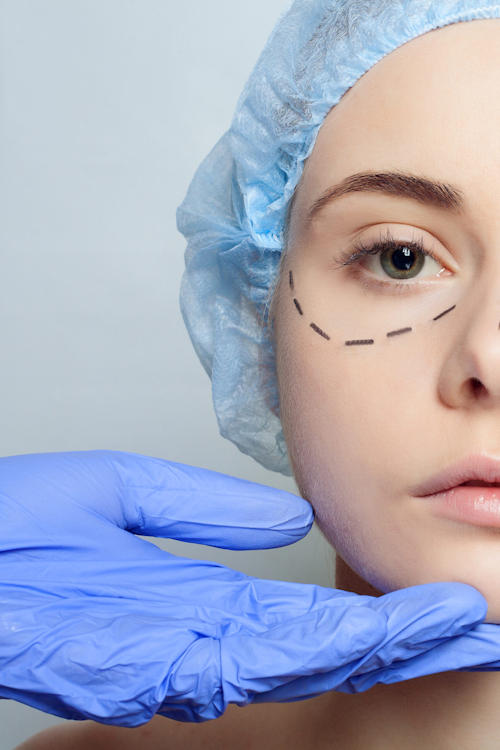
EYELID AESTHETICS (OCULOPLASTY)
Oculoplasty is a branch that deals with diseases of the eyelids and the area around the eyes. These diseases include:- Drooping eyelid (Ptosis)
- Drooping and puffiness of the eyelids (Blepharochalasis)
- Inward turning of the eyelid (Entropion)
- Outward turning of the eyelid (Ectropion)
- Masses and tumors of the eyelid (Stye, chalazion, nevus...)
- Inward turning eyelashes (Trichiasis, distichiasis)
- Fat deposits on the eyelid (Xanthelasma)
- Eyelid anomalies (Cysts, coloboma)
- Thyroid-related eye diseases (thyroid ophthalmopathy)
- Drooping of the eyebrows (Brow ptosis)
- Almond eye aesthetics
- Inability to close the eyelids (Lagophthalmos)
- Involuntary eyelid spasms (Blepharospasm)
- Botox application
1. PTOSIS (DROOPING OF THE EYELID)
If the upper eyelid covers the pupil by more than 1 mm, this is called drooping of the eyelid (ptosis).Causes of ptosis:
- Congenital (present at birth)
- Age-related
- Due to muscle diseases
- Due to neurogenic diseases
- Due to trauma
- Due to surgical procedures
2. DROOPING AND PUFFINESS OF THE EYELIDS (BLEPHAROCHALASIS)
Blepharochalasis involves sagging, puffiness, edema, and fat herniation in the skin of the eyelids. Due to the excess and weight on the eyelid, the patient appears older and more tired than they are. In advanced stages, this sagging can narrow the field of vision from the sides, causing visual impairment and headaches.Factors contributing to blepharochalasis include aging, genetic factors, thyroid diseases, allergic edema, trauma, smoking and alcohol use, and lack of sleep.
Sagging and puffiness of the eyelids can occur in both the upper and lower eyelids.
Upper eyelid surgery is performed under local anesthesia and takes about an hour. Excess skin and fat tissue on the eyelid are removed. The incision site is hidden in the eyelid crease. Bruising and swelling may occur after surgery. Stitches are removed one week after surgery. Full recovery of the eyelid takes one to two months. Eyelid surgery does not obstruct the patient's vision.
Lower eyelid surgery is performed under sedation or general anesthesia. It takes approximately 2-2.5 hours. Excess skin and fat tissue are removed. Depending on the patient's skin structure and age, the lower eyelid surgery can be performed either from the inside of the eyelid or with an incision close to the lash line on the outside. Stitches are removed one week after surgery.
3. INWARD TURNING OF THE EYELID (ENTROPION)
Entropion is the condition where the eyelids turn inward towards the eye due to aging, trauma, surgeries, or neurogenic reasons, causing the eyelashes to touch the cornea and conjunctiva. This leads to symptoms such as tearing, redness, and pain due to the eyelashes irritating the eye, and it impairs vision quality. Treatment is possible through surgical intervention, performed by experienced ophthalmologists.4. OUTWARD TURNING OF THE EYELID (ECTROPION)
Ectropion refers to the outward turning of the eyelid due to aging, trauma, masses, or neurogenic reasons.This condition causes symptoms such as redness, pain, irritation, and dryness due to the eye being exposed.
Treatment is possible through surgical intervention.
5. MASSES AND TUMORS OF THE EYELID
Styes, chalazions, sweat and sebaceous gland cysts, nevi (moles), and warts on the eyelid can be surgically corrected.Fat deposits on the eyelid are called xanthelasma. These can occur due to high cholesterol levels, often linked to genetic factors. Treatment is possible through surgical intervention. Styes are small cysts that form due to the blockage of the openings of the sebaceous glands at the lash line. These meibomian glands are prone to blockage, swelling, and inflammation, especially in individuals with seborrheic skin. This blockage can cause symptoms such as pain, redness, irritation, and swelling. Initially, there is a chance of improvement with warm compresses and medication. If the chalazion (persistent stye) does not resolve within a month, surgical treatment or injection into the cyst is planned. Surgery takes about 10-15 minutes under local anesthesia.
6. TRICHIASIS (INWARD TURNING OF THE EYELASHES), DISTICHIASIS
Eyelashes at the edge of the eyelid can turn inward due to congenital reasons or various causes in older age. Sometimes normal eyelashes turn inward (trichiasis), and sometimes an extra row of abnormal eyelashes irritates the eye (distichiasis).In these cases, symptoms such as irritation, tearing, and redness occur.
Treatment options include eyelid surgery, laser applications, and cryotherapy (freezing) of the eyelashes.




